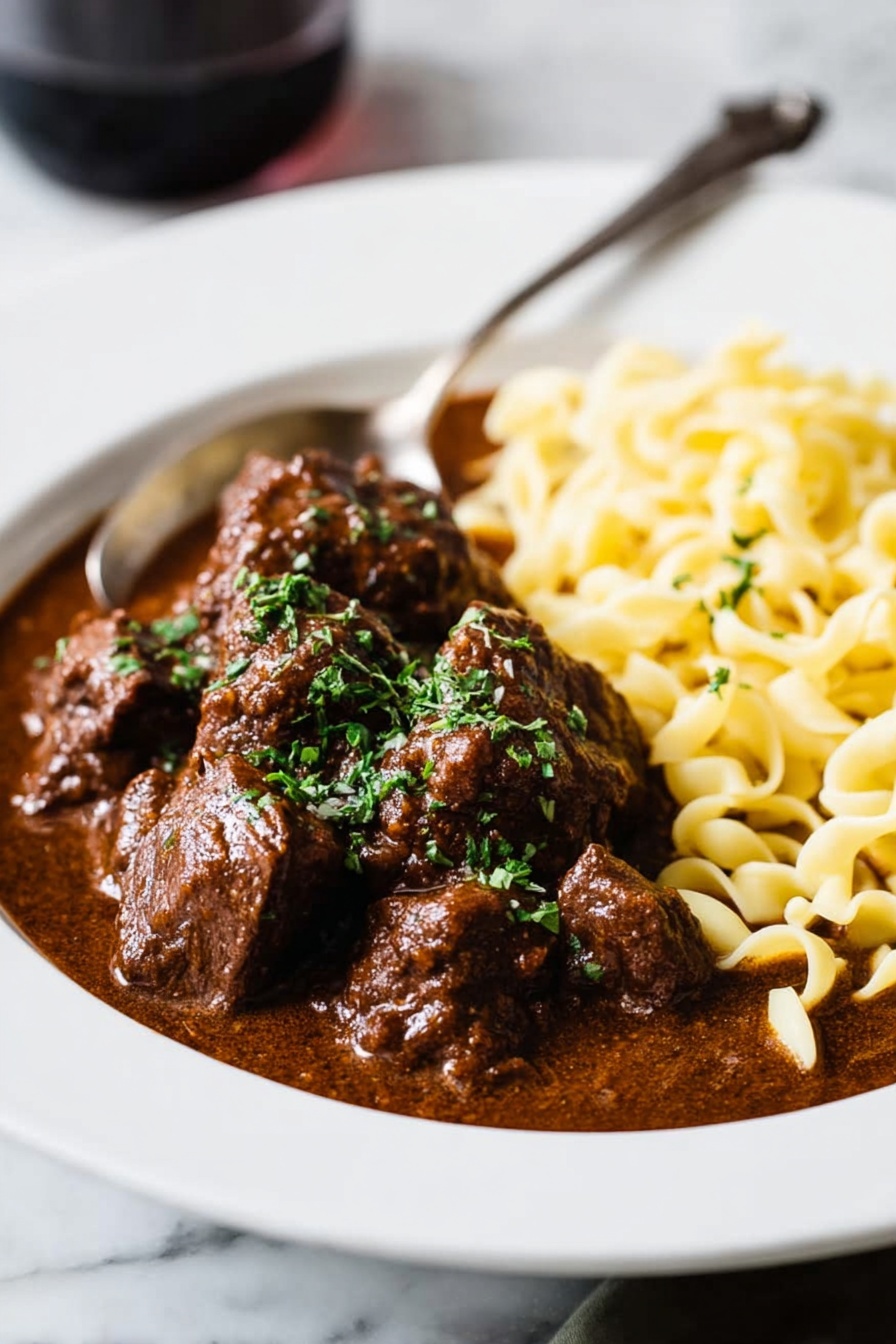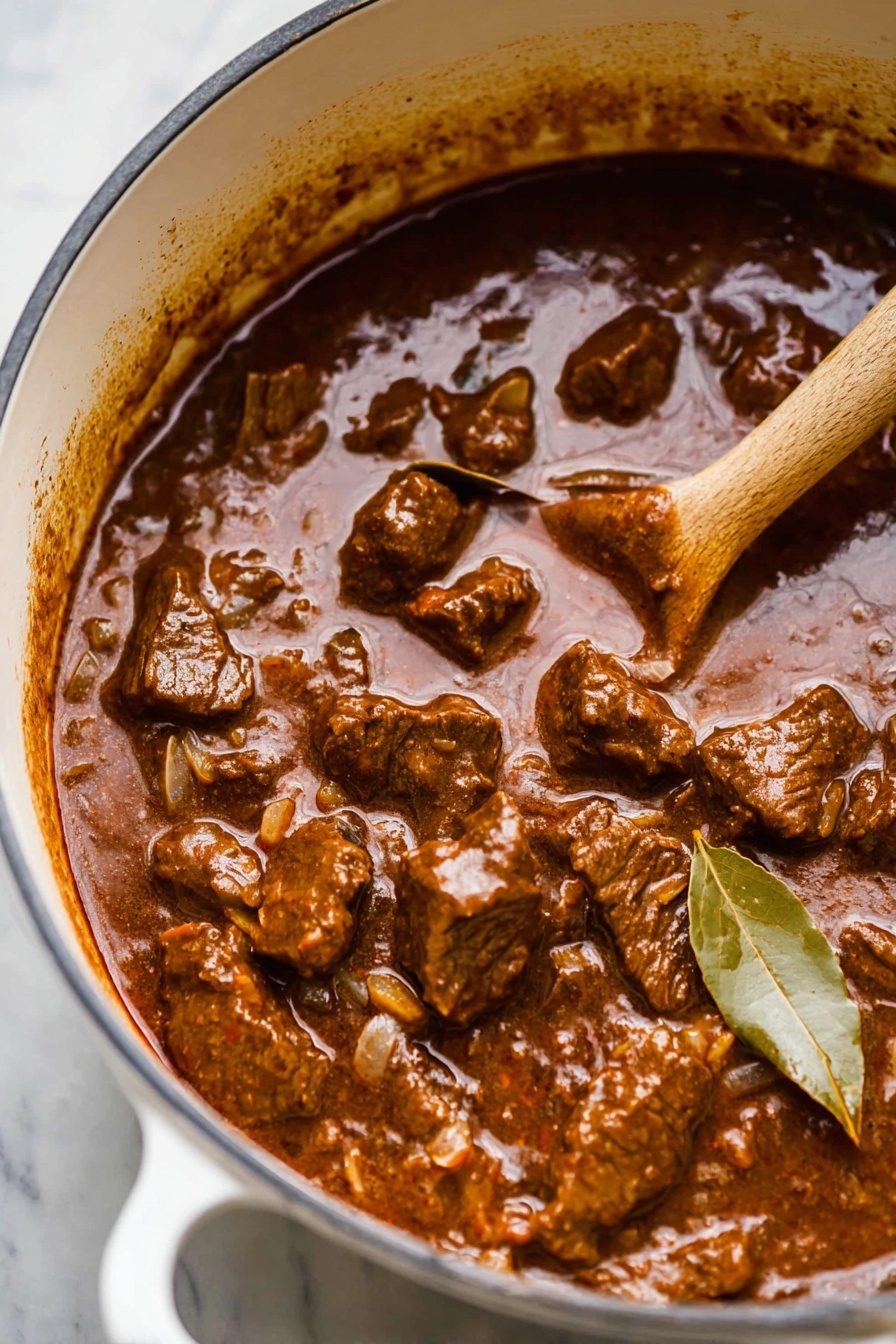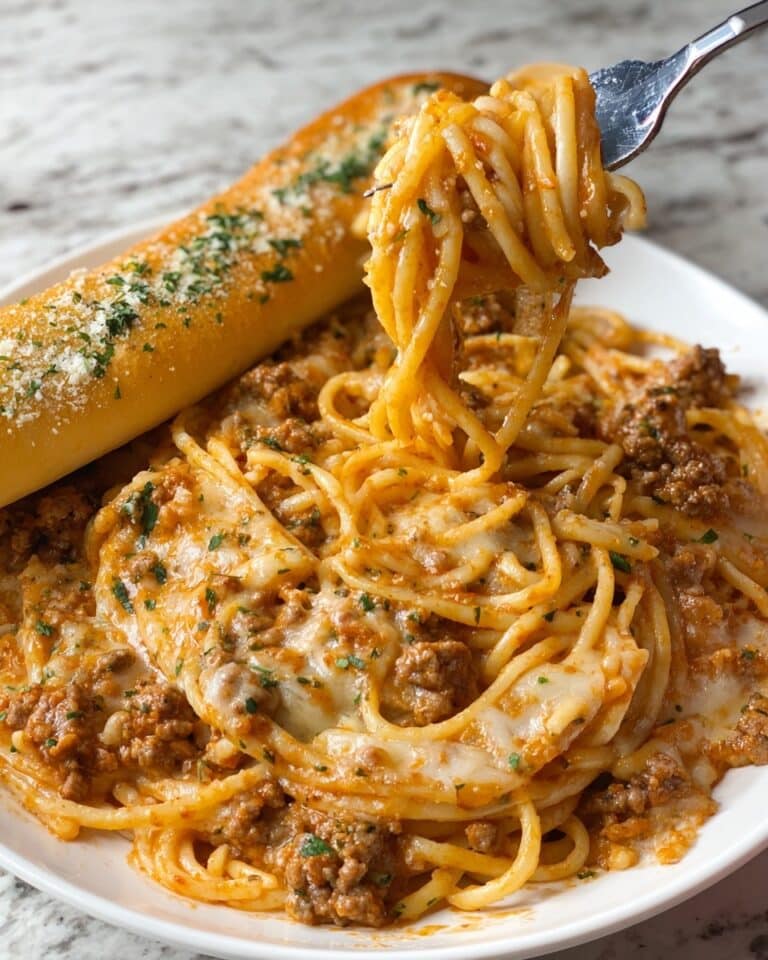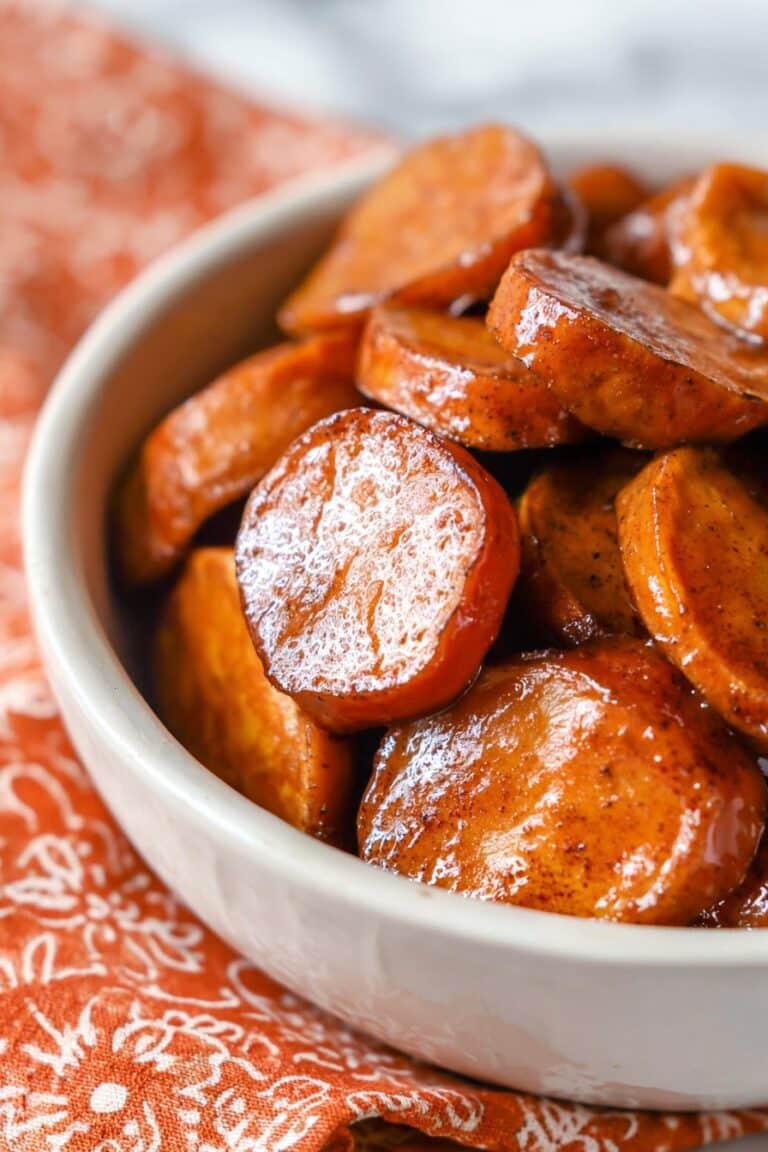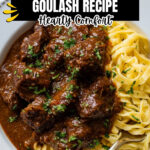German Beef Goulash Recipe
If you’ve ever been curious about the perfect comfort food that’s hearty, flavorful, and downright soul-warming, you’ve got to try this German Beef Goulash Recipe. It’s one of those dishes that combines simple, humble ingredients into something magical — tender chunks of beef simmered in a rich paprika-spiked sauce that just melts in your mouth. Stick around and I’ll walk you through every step so this becomes one of your go-to recipes, just like it did for me.
Why This Recipe Works
- Rich and Robust Flavors: The combination of sweet Hungarian paprika and caraway seeds creates a classic, authentic depth that instantly transports you to a cozy German kitchen.
- Perfectly Tender Beef: Low and slow cooking breaks down the chuck roast into melt-in-your-mouth bites, making every forkful a pleasure.
- Versatile Cooking Methods: Whether you have a Dutch oven, slow cooker, or Instant Pot, this recipe adapts beautifully without losing its signature taste.
- Balanced Comfort: It’s rich without being heavy, making it ideal for weeknight dinners or special occasions alike.
Ingredients & Why They Work
Each ingredient in this German Beef Goulash Recipe plays a role in building layers of flavor and texture. I always advise using fresh spices and quality beef to get the most authentic results. Shopping tip: buy fresh Hungarian paprika if you can—its sweetness sets this stew apart!
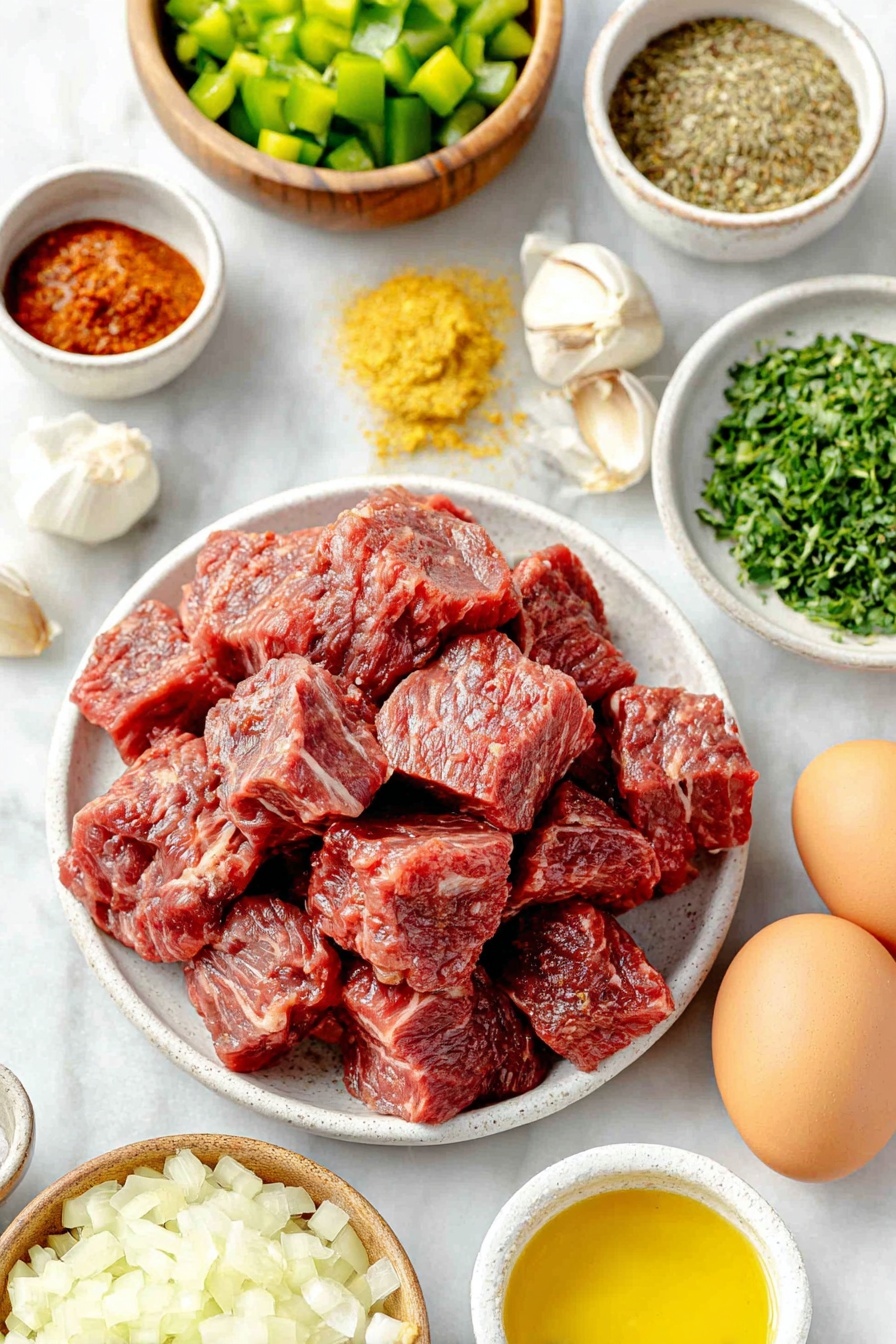
- Onions: Slowly caramelized to develop the base’s sweetness and richness.
- Olive Oil: For sautéing onions and browning beef, adding subtle fruitiness.
- Beef Chuck Roast: The well-marbled cut becomes tender and juicy after slow cooking.
- Green Pepper: Adds a mild bite and fresh crispness to break up the richness.
- Garlic: Infuses aromatic flavor without overpowering the paprika.
- Tomato (and Tomato Paste): Give a subtle bright acidity and help thicken the sauce.
- Kosher Salt & Black Pepper: Essential for seasoning and enhancing the natural flavors.
- Sweet Hungarian Paprika: The star spice, it brings the warmth and sweet pepper flavor signature to goulash.
- Dried Marjoram: Provides a gentle herbaceous note that balances the paprika with its floral hints.
- Caraway Seed: Adds that distinctive earthy, slightly anise-like nuance traditional in German cooking.
- Beef Broth: Creates a savory, unctuous cooking liquid that melds all the flavors together.
- Dry Red Wine: Adds depth and subtle acidity, brightening the stew without harshness.
- Bay Leaf: Infuses a subtle woodsy aroma.
- Fresh Parsley: A fresh finish that keeps the dish feeling lively and bright.
Make It Your Way
One of my favorite things about this German Beef Goulash Recipe is how easily it bends to your personal tastes. Feel free to tweak the herbs or adjust the thickness of the sauce. I find some days, I like it soupier; other times, thick and luxurious.
- Variation: I’ve tried adding smoked paprika for a subtle smoky kick, which makes it extra cozy on chilly evenings.
- Dietary Adjustment: If you want a lighter take, swap out half the beef broth for vegetable broth—it still tastes amazing.
- Spicy Kick: Toss in a pinch of cayenne if you’re after a little heat; it wakes up the flavors nicely without overpowering.
Step-by-Step: How I Make German Beef Goulash Recipe
Step 1: Caramelize Those Onions
Start by heating olive oil in your heavy pot over medium heat. Toss in the chopped onions with half a teaspoon of kosher salt. This is where magic begins — slow-cook these babies for 15 to 20 minutes, stirring occasionally, until they’re golden and melt-in-your-mouth tender. Don’t rush this; these caramelized onions lay the flavorful foundation so patience pays off big time.
Step 2: Brown the Beef
While the onions are softening, season the beef cubes with the rest of your salt and black pepper. Once the onions are out, crank the heat to medium-high and brown that beef in the same pot for about 5-10 minutes. You want a nice sear on each piece — it seals in juices and builds flavor through caramelization. Just don’t overcrowd the pan; brown in batches if needed.
Step 3: Build the Stew
Now, back in the pot goes the onions, along with green pepper, tomato, garlic, paprika, marjoram, caraway, tomato paste, beef broth, red wine, and the bay leaf. Stir everything together and bring to a boil on the stovetop. The smell at this point is seriously amazing — you’ll know the flavors are about to get cozy real fast.
Step 4: Slow Cook for Tenderness
Once boiling, cover the pot with the lid slightly askew to let steam escape, and transfer it to a 325°F oven. Let it cook low and slow for about 90 minutes, or until your beef is fork-tender. This gentle, even heat melts the connective tissue and thickens the sauce naturally without fuss.
Step 5: Finish with Fresh Parsley and Serve
When it’s done, sprinkle over fresh parsley to brighten all those robust flavors. Serve it piping hot with traditional spaetzle, buttered noodles, or rustic boiled potatoes for an authentic, warming experience you can’t beat.
Tips from My Kitchen
- Don’t Rush the Onions: Caramelizing gives the stew a sweetness that balances the paprika’s earthiness — take your time here.
- Brown Beef in Batches: Crowding causes steaming instead of searing, which dulls the flavor.
- Low and Slow Is Key: Whether oven or stovetop, gentle heat transforms tough cuts into melt-in-your-mouth beef.
- Check Your Paprika Freshness: Old spices lose punch, so buy recent batches for maximum flavor impact.
How to Serve German Beef Goulash Recipe
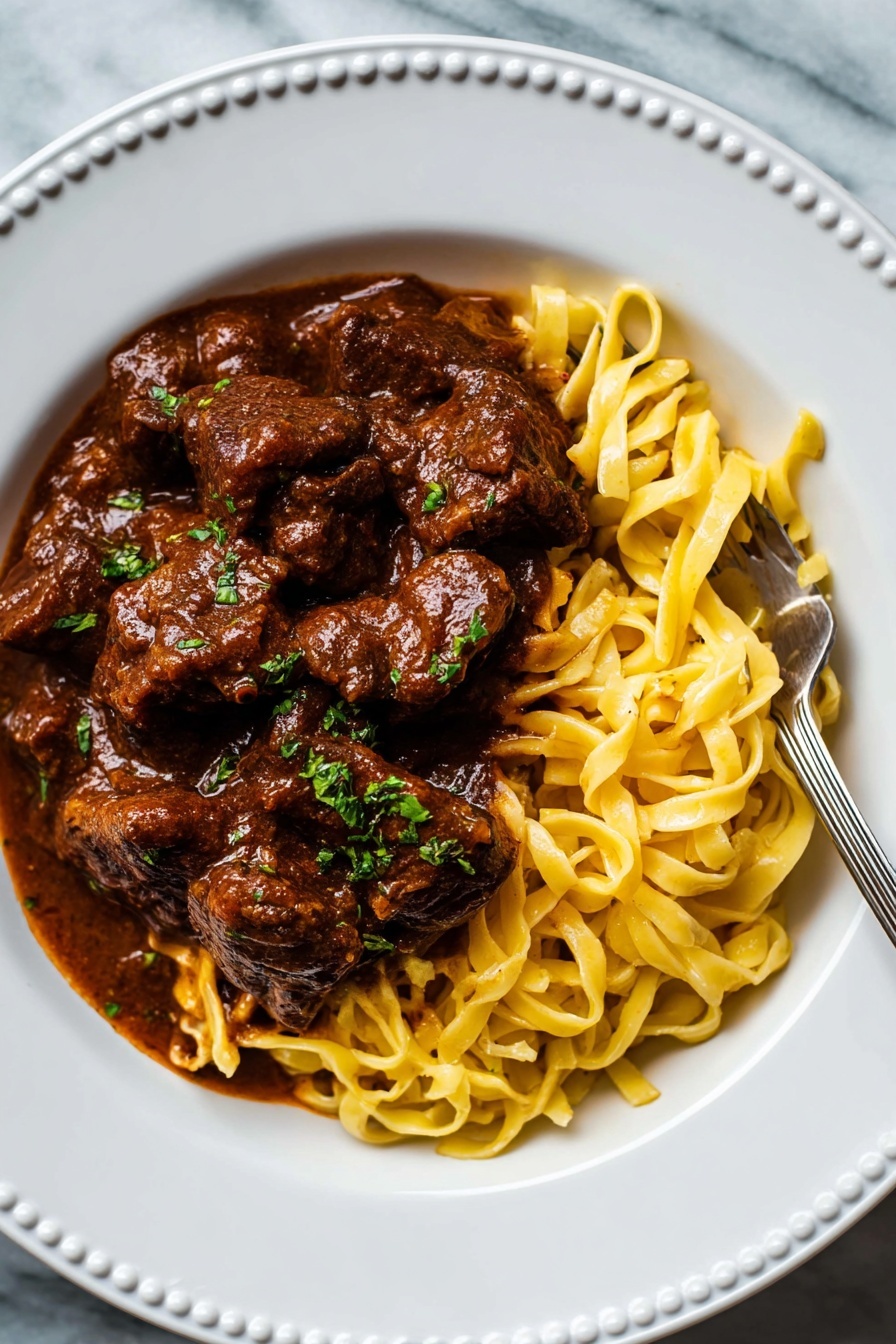
Garnishes
I love finishing this stew with a generous sprinkle of freshly chopped flat-leaf parsley. It adds a fresh, herbal lift to the rich sauce. Sometimes I throw on a dollop of sour cream for creaminess; it’s a classic touch if you’re in the mood.
Side Dishes
Traditional spaetzle is my absolute favorite alongside this goulash — those little eggy noodles soak up the sauce beautifully. Buttered egg noodles or simple boiled potatoes work just as well, especially if you want a fuss-free side. For a bit more crunch, I occasionally serve it with a crisp cucumber salad on the side.
Creative Ways to Present
For a cozy dinner party, I like serving the goulash in rustic bread bowls — it impresses guests and minimizes cleanup! You can also plate it over creamy polenta for a twist that adds a smoother texture to balance the stew. Adding a side of pickled vegetables introduces a perfect tangy counterpoint to the richness.
Make Ahead and Storage
Storing Leftovers
I always store leftovers in an airtight container in the fridge, and you’ll be happy to know that German Beef Goulash tastes even better the next day as the flavors continue to meld. Just cool it completely before refrigerating for best results.
Freezing
This stew freezes beautifully! I portion it into freezer-safe containers and it keeps well for up to 3 months. When you’ve had a busy week, just thaw overnight in the fridge, and dinner is practically ready to go.
Reheating
Reheat gently over low heat on the stove, stirring occasionally to prevent sticking. If the sauce thickened too much in the fridge, just add a splash of beef broth or water to loosen it back up. Microwaving works, too, but I prefer stovetop for even warmth and to preserve that freshly made taste.
FAQs
-
Can I use a different cut of beef for this German Beef Goulash Recipe?
Absolutely! While chuck roast is ideal due to its marbling and tenderness after slow cooking, beef stew meat or shoulder cuts also work well. Avoid very lean cuts like sirloin, as they can become tough during the long cooking process.
-
What if I don’t have Hungarian paprika?
While Hungarian sweet paprika is preferred for its sweet, mild flavor, you can substitute with regular sweet paprika in a pinch. Smoked paprika will change the flavor profile but adds its own lovely smoky character if you’re open to experimentation.
-
Can I make this recipe in a slow cooker or Instant Pot?
Definitely! After browning the beef and sautéing onions, transfer everything to a slow cooker for 6-8 hours on low or 3-4 hours on high. In an Instant Pot, pressure cook on high for 35 minutes and then let natural release. Both methods yield tender, flavorful results.
-
How thick should the sauce be for authentic German Beef Goulash?
The sauce should be hearty and slightly thick but still saucy enough to spoon over noodles or potatoes. If it’s too thin, simmer uncovered for a bit to reduce, or whisk in a cornstarch slurry to thicken before serving.
-
Is German Beef Goulash spicy?
This recipe is traditionally mild with a sweet paprika flavor, not spicy-hot. However, you can add chili powder or cayenne pepper if you prefer some heat. It’s all about your personal taste.
Final Thoughts
This German Beef Goulash Recipe has become a staple in my kitchen for those days when you need a meal that’s both comforting and full of character. Its hearty, paprika-rich sauce paired with tender beef hits every spot for satisfying dinner cravings. I hope you find as much joy in making and eating this dish as I do — it’s like a warm hug in a bowl you’ll want to come back to again and again.
Print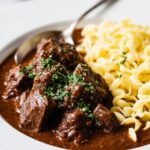
German Beef Goulash Recipe
- Prep Time: 30 minutes
- Cook Time: 2 hours
- Total Time: 2 hours 30 minutes
- Yield: 4 servings
- Category: Main Course
- Method: Baking
- Cuisine: German
Description
Classic German Goulash is a hearty and flavorful beef stew made with tender chunks of beef, sweet Hungarian paprika, onions, peppers, and a rich tomato-based broth. This traditional dish is perfect for a comforting dinner and can be cooked in the oven, stovetop, slow cooker, or Instant Pot to suit your preferences.
Ingredients
Main Ingredients
- 1½ pounds onions chopped
- 2 tablespoons olive oil
- 2 pounds beef chuck roast or stew beef cubed into 1 to 1 1/2″ pieces
- ½ green pepper chopped
- 3 cloves garlic minced
- ½ tomato seeded and diced, (about 1/3 cup)
- 1 teaspoon kosher salt divided
- ½ teaspoon black pepper
- 2 tablespoons sweet Hungarian paprika
- 2 teaspoons dried marjoram
- 1 teaspoon caraway seed
- 2 tablespoons tomato paste
- 2 cups beef broth or bouillon
- ½ cup dry red wine
- 1 bay leaf
- ¼ cup chopped fresh parsley
Instructions
- Preheat and Prepare Onions: Place the oven rack in the center and preheat to 325°. Heat 2 tablespoons olive oil in a heavy pot or Dutch oven over medium heat. Add 1½ pounds chopped onions and ½ teaspoon kosher salt. Cook for 20 minutes, stirring occasionally, until onions are very tender and golden.
- Brown the Beef: Remove onions to a separate dish. Season 2 pounds beef with remaining ½ teaspoon kosher salt and ½ teaspoon black pepper. Add beef to the pot and cook over medium-high heat for 10 minutes until browned on all sides.
- Add Vegetables and Seasonings: Stir back in the onions, then add ½ chopped green pepper, ½ diced tomato, 3 minced garlic cloves, 2 tablespoons sweet Hungarian paprika, 2 teaspoons dried marjoram, 1 teaspoon caraway seed, and 2 tablespoons tomato paste. Mix to combine.
- Add Liquids and Bay Leaf: Pour in 2 cups beef broth and ½ cup dry red wine. Add 1 bay leaf. Bring the mixture to a boil on the stovetop.
- Oven Cook: Place the lid on the pot slightly askew to allow steam to escape. Transfer the pot to the preheated oven and cook for 1½ hours or until the beef is tender.
- Finish and Garnish: Remove the pot from the oven, discard the bay leaf, and stir in ¼ cup chopped fresh parsley. Serve with spaetzle, buttered noodles, or potatoes.
Notes
- For thicker sauce, mix 1½ teaspoons cornstarch with 2 teaspoons cold water to form a slurry, add to stew and boil until thickened before adding sour cream.
- Use low-sodium beef broth to prevent the dish from becoming too salty as it reduces.
- Check expiration dates on spices, especially pre-ground, as they lose potency after 6-12 months.
- Alternative cooking methods include slow cooker (low 6-8 hours or high 3-4 hours), stovetop simmer (1½ to 2 hours), or Instant Pot (high pressure for 35 minutes with natural release).
Nutrition
- Serving Size: 1 serving
- Calories: 450 kcal
- Sugar: 6 g
- Sodium: 550 mg
- Fat: 20 g
- Saturated Fat: 6 g
- Unsaturated Fat: 12 g
- Trans Fat: 0 g
- Carbohydrates: 18 g
- Fiber: 4 g
- Protein: 40 g
- Cholesterol: 120 mg

